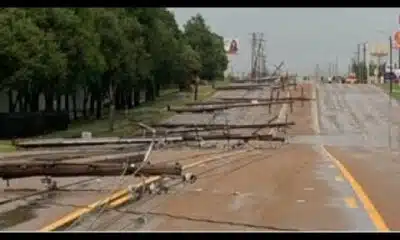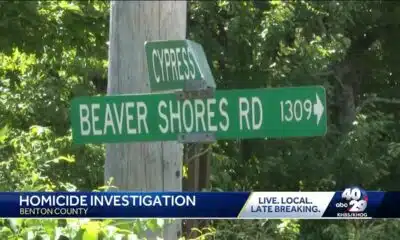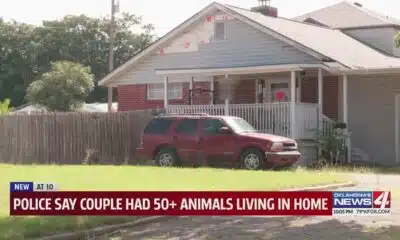News from the South - Missouri News Feed
Trump’s cuts to federal wildfire crews could have ‘scary’ consequences
Trump’s cuts to federal wildfire crews could have ‘scary’ consequences
by Alex Brown, Missouri Independent
February 18, 2025
ISSAQUAH, Wash. — President Donald Trump’s moves to slash the federal workforce have gutted the ranks of wildland firefighters and support personnel, fire professionals warn, leaving communities to face deadly consequences when big blazes arrive this summer.
“There’s going to be firefighters that die because of this, there will be communities that burn,” said Steve Gutierrez, a union official who served 15 years as a firefighter with the U.S. Forest Service.
Gutierrez now serves as a labor relations representative with the National Federation of Federal Employees, which represents government workers. He said thousands of wildland firefighters have had their jobs thrown into limbo by Trump’s government-wide hiring freeze.
Brian Fennessy, chief of the Orange County Fire Authority and president of the California Fire Chiefs Association, echoed that concern. “The public needs to know they’re at risk,” Fennessy said. “If the public knew all of this, they would lose their minds.”
Federal agencies depend on an army of seasonal firefighters to fill their ranks during the months when wildfires are most active. Scott, a Forest Service firefighter with six years of experience in the Western United States, who asked to be identified by a pseudonym to avoid retaliation, is among those whose role has been thrown into uncertainty.
“It’s just going to be a disaster for the wildfire response this season,” he said.
Scott was slated to move to a new Forest Service fire station this spring. But following the federal hiring freeze, he was told by his captain that it’s unclear whether his new job still exists. Thousands of his colleagues are in a similar state of limbo.
In a statement to Stateline, the Forest Service said wildland firefighting jobs are considered public safety positions that are exempted from the hiring freeze, and the agency is working with the federal Office of Personnel Management on those positions. The agency did not respond to follow-up questions about the number of unfilled positions under review.
The U.S. Department of the Interior and Bureau of Indian Affairs did not grant Stateline interview requests.
Federal agencies employed more than 17,000 wildland fire staffers last year, many of them in seasonal roles. This year, many of those workers had job offers rescinded — or had their transfers and promotions put on hold — just as they were set to begin onboarding and training for the 2025 fire season.
Trump’s efforts to cut the federal workforce are led by his newly created commission dubbed the Department of Government Efficiency, helmed by billionaire Elon Musk, the world’s richest man.
Aside from the hiring freeze, the Forest Service fired an additional 3,400 staffers this week, many of whom provided critical support for wildfire operations. Meanwhile, Trump’s freeze on federal spending has cut off funding for projects such as prescribed burns to reduce future risk. Wildfire officials offer mixed reports on whether that funding has been restored in the wake of judicial rulings.
“We are watching a valuable [federal] partner in wildland fire suppression go into this fire season unnecessarily handicapped,” said Thomas Kyle-Milward, wildfire communications manager with the Washington State Department of Natural Resources. “That’s concerning.”
States, tribes and fire chiefs are all watching the situation closely. Officials say they’re preparing for a fire season in which they may have minimal federal support. While they plead with Trump to reverse course quickly, they fear much of the damage may be irreversible. Many wildland fire officials noted that seasonal workers will likely move on to other jobs if their position with a federal agency is in doubt.
“If there’s not enough federal firefighters, that affects everybody in the state,” said Jake Rhoades, fire chief of Buckeye Fire-Medical-Rescue Department in the Phoenix suburbs and president of the Arizona Fire Chiefs Association. “That’s scary for me.”
Rhoades and others noted that firefighters need significant training and qualifications to fill leadership positions. Trump’s actions have delayed that onboarding process. As a result, engine crews could be grounded this summer because they don’t have a certified leader, or teams could be sent into harm’s way without the proper training.
The federal role
Wildland fire response in the U.S. is a collaborative effort shared by a variety of entities, from tiny local fire districts to massive federal agencies. In Western states especially, the feds play a crucial role. Agencies manage a vast landscape of national forests, national parks and Bureau of Land Management parcels. The Bureau of Indian Affairs also provides wildfire response on tribal reservations.
While state agencies have invested heavily in their own wildfire crews, they say the federal agencies are critical partners.
“If they’re unable to fill the majority of their positions, it would have an impact on everybody this summer,” said Vaughn Jones, wildland fire management section chief with the Colorado Department of Public Safety. “We have to partner with them every day of every fire season.”
Trump’s orders have thrown those agencies into chaos.
“I hear it multiple times a day from folks who are applying for jobs, from folks who are trying to fill positions, and they’re all getting stymied,” said Bobbie Scopa, executive secretary with Grassroots Wildland Firefighters, a nonprofit that advocates for federal staffers. “These folks are worried about their families and paying the mortgage, and they’re worried about their physical safety if they’re going to be responding to fires with a crew that’s not staffed up all the way.”
Federal firefighters corroborated that account.
“They’re saying there’s this public safety exemption, and that’s a blatant lie, because I’m a wildland firefighter and my job has been frozen,” said Scott, the Forest Service employee.
Scott said many of his colleagues were among the 3,400 Forest Service employees fired last week. While the agency said those cuts do not include firefighters, wildland fire experts note that many staffers in other roles hold wildfire certifications and serve on the line during fire season. And nearly all of them play critical support roles for the agency’s wildfire response.
Another Forest Service firefighter, who asked to remain anonymous, said the cuts to his unit included an aviation manager who supervised helicopter contracts and crews, as well as mapping specialists who provided key information to wildfire crews.
“There’s going to be days where we can’t call a helicopter because of staffing,” he said. “From a mapping perspective, our intelligence-gathering is going to be really affected by losing those people.”
Scott said he’s begun applying for other jobs, but is still holding out hope he can stay with the Forest Service. But he said many other firefighters will have moved on by the time the feds get their act together.
A wildfire planner in a Western state, who asked to remain anonymous to avoid retaliation, said the impacts of Trump’s cuts will be felt long beyond this fire season.
“This could end up costing us a generation of firefighters,” he said. “They think a two-month delay doesn’t mean anything, but people get laid off and they find other work. This is a very specific skillset, and there ain’t many people in this work.”
Officials at all levels say that recruitment and retention of firefighters is already a major challenge. Wildland fire workers must accept unsteady seasonal positions, with grueling hours and exposure to dangerous conditions and cancer-causing smoke. Many suffer from mental health issues as a result. And the profession’s paltry salaries, experts say, rarely match the demands.
Contingency plans
State and local leaders say they’re still working to make sense of the federal chaos. In Nevada, where 86% of the land is managed by federal agencies, the turmoil could have an outsized impact.
“Obviously, we’re a little nervous right now,” said Kacey KC, the Nevada state forester and fire warden. “We’re putting contingency plans in place for emergency hires for fire season, if need be.”
KC said a loss in federal support would be a huge blow to Nevada’s wildfire response efforts. As the state works to staff up its own crews, it has seen an increase in applicants from federal agencies, perhaps indicating that the uncertainty is driving Forest Service and BLM employees to other jobs.
In Arizona, officials say they plan to lean on an interstate compact that allows them to share resources with Colorado, Kansas, Nebraska, New Mexico, North Dakota, South Dakota, Wyoming and the Canadian province of Saskatchewan. Jones, the Colorado official, said such agreements could be essential this year.
“If [federal support] is diminished, those compacts and the states finding ways to make things happen will be critical,” he said.
Nevada is one of the few states that has not signed onto a wildfire compact. KC said she’s pushing lawmakers to authorize the state to join such agreements.
In Washington state, the Department of Natural Resources is planning to meet with regional Forest Service leaders to assess what adjustments they may have to make.
“Are the feds able to field an adequate number of firefighters that they can cover their jurisdiction within Washington state?” said Kyle-Milward, the DNR official. “We’re concerned that they won’t.”
In recent years, the state has invested heavily in its own response, staffing up to 700 firefighters, in an effort to become less dependent on federal agencies.
Tribal nations are also trying to make sense of the situation. The federal Bureau of Indian Affairs employs thousands of firefighters that respond to fires on tribal lands. And many tribes staff their own wildfire crews using federal funding that’s now in doubt.
For the Confederated Tribes of the Colville Reservation, in northeast Washington state, it’s unclear whether they’ll be able to hire the seasonal firefighters they rely on during wildfire season.
“It’s definitely a touch-and-go situation right now,” said Chairman Jarred-Michael Erickson. “We’re hoping to get answers sooner than later. I really hope they’re looking at this, because wildfire season comes really quick and if you’re not prepared…”
In 2023, wildfires burned more than 57,000 acres on the Colville Reservation.
Prevention work
Trump’s freeze on federal spending is another major concern for wildfire professionals. In Washington state, for instance, officials have lost access to more than $200 million in wildfire preparedness funds, the Seattle Times reported. That money was intended to help agencies purchase equipment, train local departments, plan evacuation routes and conduct fuels reduction projects like prescribed burns to reduce risk.
Wildfire experts say the Inflation Reduction Act and infrastructure law passed under President Joe Biden made significant investments in projects to improve forest health and prevent out-of-control megafires. Trump has attempted to block those grants.
“If we’re not able to do that in certain areas, then the fuel load is going to be impacted, and that increases the possibility of the magnitude of some of these fires,” said Rhoades, the president of the Arizona Fire Chiefs Association.
The Western wildfire planner, who asked to remain anonymous, said the funding freeze is threatening projects to improve the safety of local communities.
“[Trump] is driving the wildfire prevention train off the rails,” he said. “I’m hoping that this year is not the year that the big fire shows up in my neighborhood.”
In California, leaders have not yet seen a cutoff in federal money to support wildfire projects, said Patrick Wright, director of the California Wildfire and Forest Resilience Task Force, a coalition of state and federal agencies. He noted that the state has committed billions of its own funds to ensure the work continues.
Wright said the state expects to retain a strong partnership with federal land management agencies. But he noted that the recent firings of thousands of federal staff would impact the pace of their work.
“It will slow things down,” he said. “We’re all facing shortages in workforce across the board. Clearly, losing more of that workforce is going to have an impact.”
Stateline is part of States Newsroom, a nonprofit news network supported by grants and a coalition of donors as a 501c(3) public charity. Stateline maintains editorial independence. Contact Editor Scott S. Greenberger for questions: info@stateline.org.
Missouri Independent is part of States Newsroom, a nonprofit news network supported by grants and a coalition of donors as a 501c(3) public charity. Missouri Independent maintains editorial independence. Contact Editor Jason Hancock for questions: info@missouriindependent.com.
The post Trump’s cuts to federal wildfire crews could have ‘scary’ consequences appeared first on missouriindependent.com
News from the South - Missouri News Feed
Jackson County lawmakers override Frank White's vetoes
SUMMARY: The Jackson County Legislature unanimously overrode three vetoes by County Executive Frank White Jr., including his veto delaying a recall election now set for August 26. Legislator Megan Smith abstained, expressing concerns about disenfranchising military and overseas voters due to federal absentee ballot timing requirements. Chair DaRon McGee defended the Legislature’s timeline, blaming White for delays. The election boards have sued over the legality of the recall election, with court hearings upcoming. Additionally, the Legislature overrode vetoes on measures to let voters decide if the county assessor should be elected and extended the property tax credit deadline for seniors. White urges a November election to ensure legality and integrity.
The post Jackson County lawmakers override Frank White's vetoes appeared first on fox4kc.com
News from the South - Missouri News Feed
Ozarks weather whiplash in 2025 explained
SUMMARY: Spring and summer 2025 in the Ozarks have seen extreme weather swings, including multiple severe wind and tornado events, especially near Springfield. Since May 1, over 40% of days had rain, often heavy, with hot, muggy dry days between. Notable events include deadly EF-3 tornadoes in March and April, significant windstorms in April and June, and record-breaking rainfall in April and May. This active pattern is linked to a disrupted Polar Vortex from sudden stratospheric warming, an amplified and slow jet stream, a La Niña to neutral ENSO transition, and elevated Gulf of Mexico water temperatures increasing atmospheric moisture. These factors combined caused the unusual weather volatility of 2025.
The post Ozarks weather whiplash in 2025 explained appeared first on www.ozarksfirst.com
News from the South - Missouri News Feed
Parking lot shoot out leaves 5 injured in Tower Grove South
SUMMARY: Five people were injured in a parking lot shootout Sunday in the Tower Grove South area of St. Louis. The incident occurred at the INAD Motor parking lot near Morganford Road and Beck Avenue. Police confirmed that at least 30 shots were fired and two vehicles were involved, including a Mercedes reported stolen on July 11. Among the victims are three juveniles and two young adults aged 18 to 24. All were transported to area hospitals and are in stable condition. The scene remains active, and investigators continue to gather details on what led to the violent exchange of gunfire.
District 2 officers were alerted to a shooting in the Tower Grove South neighborhood, leaving five injured.
According to the St. Louis Metropolitan Police Department (SLMPD), officers were alerted to reports of a shooting around 8 p.m. Thursday at Morganford and Beck Avenue.
St. Louis News: FOX 2 covers news, weather, and sports in Missouri and Illinois. Read more about this story or see the latest updates on our website https://FOX2Now.com
Follow FOX 2 on social media:
YouTube: https://www.youtube.com/FOX2Now
Facebook: https://www.facebook.com/FOX2Now/
Twitter: https://twitter.com/FOX2Now/
Instagram: https://www.instagram.com/fox2now/
TikTok: https://tiktok.com/@fox2now
SnapChat: https://www.snapchat.com/add/fox2now
-
News from the South - Tennessee News Feed5 days ago
Bread sold at Walmart, Kroger stores in TN, KY recalled over undeclared tree nut
-
News from the South - Arkansas News Feed7 days ago
Man shot and killed in Benton County, near Rogers
-
News from the South - Georgia News Feed1 day ago
Aiken County family fleeing to Mexico due to Trump immigration policies
-
News from the South - Alabama News Feed6 days ago
Girls Hold Lemonade Stand for St. Jude Hospital | July 12, 2025 | News 19 at 10 p.m. – Weekend
-
News from the South - Georgia News Feed7 days ago
Anti-ICE demonstrators march to Beaufort County Sheriff's Office
-
News from the South - Oklahoma News Feed7 days ago
Police say couple had 50+ animals living in home
-
Mississippi Today4 days ago
Coast judge upholds secrecy in politically charged case. Media appeals ruling.
-
Mississippi Today1 day ago
Driver’s license office moves to downtown Jackson









































